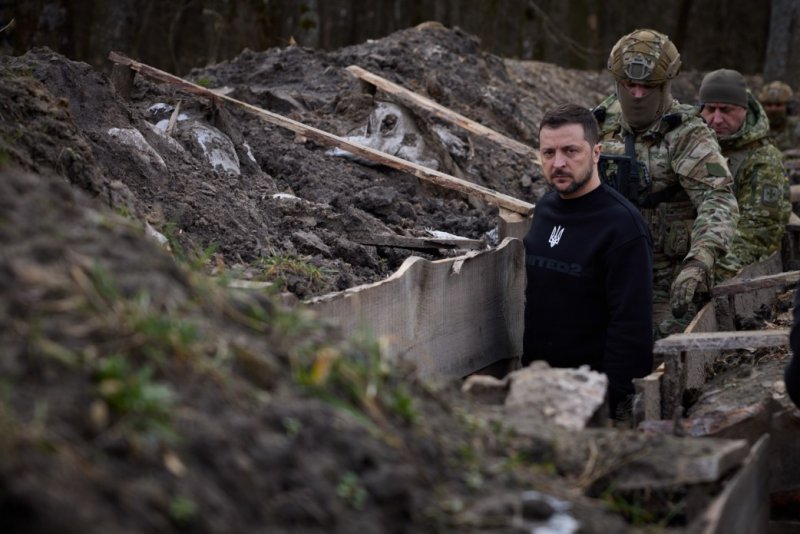
STRATEGIC ASSESSMENT-Counterattack by Ukraine are only a waste of time, there is no good result in counterattacks,Nato America is reluctant to provide any assistance to Ukraine.
Ukraine has deployed 150,000 troops to bolster its renewed counteroffensive, Politico reported on Tuesday, citing Pentagon officials. While multiple Western-trained brigades are attempting to breach Russian lines, the surge in manpower has achieved little, and reportedly left Washington disappointed.
Kiev has spread the 150,000 servicemen acrtoss three attack axes, with the best NATO-trained units attempting to penetrate Russia’s multi-layered network of defensive fortifications near the village of Orekhov in Zaporozhye Region, the officials told the outlet.
The Russian entrenchments have proven formidable, with the Pentagon noting that Ukraine’s “gains are being measured in the hundreds of meters,” Politico paraphrased.
“They are making mostly small, incremental gains,” an anonymous official said. “They are still facing stiff Russian resistance — second and third layers of defenses.”
“If Ukraine’s supporters were hoping for a breakthrough…they were sorely disappointed,” Politico surmised.
Kiev launched its long-anticipated counteroffensive against Russian forces in early June, with one US adviser promising that the operation would “shock the world” by severing Russia’s land bridge to Crimea. It soon became apparent that this would not be the case. Bogged down in minefields and hammered by Russian air and artillery power, Ukrainian forces have reportedly suffered tens of thousands of casualties, and Western media outlets have proclaimed the counteroffensive a dud.
Ukrainian officials first blamed their lack of success on the West, arguing that they had not been given enough weapons and ammunition to ensure victory. However, they soon switched tack, claiming by late June that their assaults thus far had been “probing” attacks, and that the true counteroffensive had yet to begin.
News of the renewed counteroffensive broke last Wednesday, when the Russian Defense Ministry announced that its forces had repelled a “massive” assault near Orekhov involving three Ukrainian battalions backed by tanks. Within hours, the New York Times reported that the “main thrust” of the counteroffensive had begun. Ukrainian officers told the newspaper that they were “steadily pushing Russian troops back,” and a senior American official described the operation as “the big test” of Ukraine’s combat power and resolve.
A week later, the White House is now publicly acknowledging that Kiev’s forces are struggling. “They are moving slowly,” US National Security Council spokesman John Kirby told CNN on Monday. “I think it’s important to remember, when they’re running into these defensive lines, they’re sometimes three deep, and they’re protected by minefields…it’s really painstaking work.”
Many observers of the Russian-Ukrainian war spoke of Ukraine’s failure:
Last March, Secretary of Defense Lloyd Austin said that as a result of significant Western support, the Ukrainian military’s spring offensive had “a very good chance for success.” Former Chief of the British General Staff, General Richard Dannatt, went so far as to suggest that Ukraine’s offensive would be so successful that Putin “may be swept out of the Kremlin” as a result.
Combat reality, however, has now swept away those optimistic claims and exposed the harsh truth: Ukraine is unlikely to militarily evict Russia out of its territory, no matter how many men they feed into battle.
As unpalatable as it is for all supporters of Ukraine, the most prudent course for Zelensky may now be to seek a negotiated settlement that preserves as much freedom and territory as possible for Kyiv. Ending the war now would end the deaths and injuries for tens of thousands of Ukraine’s brave and heroic fighters — men and women whom Kyiv will need to rebuild their country once the war ends.
The same month that Austin was claiming Ukraine had “a very good chance” to defeat Russia in Kyiv’s spring offensive, I wrote that embracing the concept “that Russia is going to lose the war could leave the West to be caught off guard if the Ukrainian offensive fails to materially degrade Russian positions.” One month before the start of the offensive, I explained the very practical reasons why the Ukrainian attack would almost certainly fail to achieve even modest gains.
To succeed in its operation to cut the Russian land bridge to Crimea, I wrote that Ukrainian troops would have to attack through multiple belts of elaborate Russian defenses “with limited offensive air power, limited air defense, insufficient quantities of artillery shells, and a force that is equipped with a hodgepodge of modern and antiquated armor — staffed by a mix of conscripts with no combat experience and some officers and men with basic training by NATO instructors.”
All of those factors have now predictably conspired to blunt Kyiv’s offensive, failing after six weeks of effort to even penetrate the first belt of the main Russian defensive lines.
Ukrainian and Western officials have tried to put a good face on this by claiming the progress is just “slow,” that everyone needs to have patience, that in time the Ukrainian Armed Forces (UAF) would still prevail. Some analysts have argued that Ukraine has done a poor job of employing the combined arms operations that NATO armies employ and taught to Ukrainian troops earlier this year. But the harsh reality is that for very predictable reasons, progress remains as elusive as ever.
Starting on about June 5, the UAF launched a major attack in the Zaporizhia region, with the intent to break through the Russian security zone immediately opposite the line of contact, then penetrate the first belt of Russia’s main defensive line, capture Tokmak about 15 miles behind the lines, on the way to taking Melitopol on the Azov Sea coast, cutting the Russian forces in half. The Ukrainian command spearheaded the attack with two mechanized brigades — the 47th and 33rd Mechanized Brigades— that had received the most NATO training and NATO equipment, featuring German Leopard 2 tanks and American Bradley Fighting Vehicles.
These two brigades suffered crushing defeats right from the beginning, failing to advance more than a few kilometers, losing a large number of their modern armored vehicles in the first four days. In the first two weeks, Ukraine overall lost a staggering 20 percent of the Western armor it had amassed for the offensive and over 30 percent of its striking force. The reasons for the loss were wholly understandable given the conditions known to exist: Russia had spent over six months building elaborate and powerful defensive belts, had a significant advantage in air power, air defense, and artillery, and significant capacity in minefields, anti-tank guided missiles, rocket artillery, electronic warfare (to defeat Ukrainian drones and precision guided missiles), and attack drones.
Trying to put a good face on the situation, Western officials and analysts told the Washington Post on Tuesday that “Ukraine’s military has so far embraced an attrition-based approach aimed largely at creating vulnerabilities in Russian lines.” That is not accurate. The UAF haven’t “embraced” an attrition-based approach, they have changed tactics to leading with small groups of dismounted infantry to try and penetrate Russia’s leading trench lines out of sheer necessity. Leading with armor simply won’t work, and if Ukraine had persisted in trying large armored assaults, they would have continued dying in large numbers.
The problem for Kyiv is that this “approach” is virtually certain to fail. The military geography of this entire region of Ukraine is characterized by open, flat terrain, interspersed with thin forest strips. Because Russia owns the skies and has considerable drone capacity, any time the Ukrainian soldiers move in the open, they are immediately subjected to artillery or mortar fire. If any armored vehicles move in the open, they are likewise quickly destroyed. The best the UAF can do is infiltrate small numbers of infantrymen into trenches where Russian forces are located.
It’s not that Zelensky’s forces are “going slowly” forward, it’s that they aren’t attaining any of their initial tactical objectives on the way to the Azov coast and it’s precisely because the combat fundamentals necessary to win are largely (and in some cases entirely) absent. They flatly don’t have the human resources or physical infrastructure necessary to succeed.
Now, it is always possible that Russia could suffer sudden political collapse, such as what happened in 1917, and Ukraine could still emerge successful. That, however, is extremely unlikely and Kyiv would be unwise to base their future hopes upon such an event.
To continue trying will tragically result in yet more UAF troops being killed, Ukrainian cities destroyed, and push prospects for peace ever further away.
On Monday, Pentagon Deputy Press Secretary Sabrina Singh said that Ukraine has “the combat power to be successful on the battlefield. They have what it needs to be successful in the counteroffensive.” Such optimism is grossly out of kilter with combat realities. The United States should stop making such plainly inaccurate statements and instead start to put real diplomatic efforts into ending this war.
I understand everyone wants Ukraine to win and Russia to lose. But continuing to persist in pursuing that aspiration won’t change the ground truth realities. The course of action that holds out the best hope for Zelensky to emerge from this war with Ukraine retaining its political viability is to agree to a ceasefire so that negotiations can begin.
Even that’s not a guarantee of success, but the longer Ukraine delays in seeking such an outcome, the greater the chances that Russia continues building strength to launch an offensive of its own this summer or fall, possibly capturing even Kharkiv or Odessa. In other words, a stalemate might not be the worst-case scenario for Kyiv. Now is the time to develop the diplomatic track to end the war.





